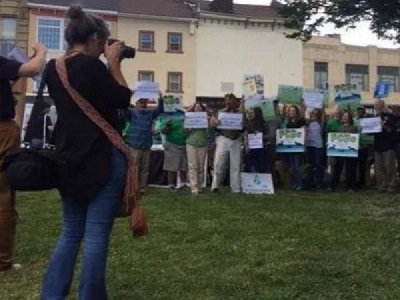
Posted on July 4, 2017
By Jack Howland, Poughkeepsie Journal
Fifty-five years.
The number drew groans and murmurs throughout the Poughkeepsie Grand Hotel ballroom.
That’s how long Gary Klawinski, director of the U.S. Environmental Protection Agency Region 2, said it could take before a person will be able to safely eat a fish meal from the Hudson River once a month. It’s an estimate found in the EPA’s five-year review of its Superfund cleanup efforts of toxic chemicals in river, which he and other EPA officials explained and frequently defended Wednesday in an informational session that drew hundreds of people.
Citizens and environmental activists filled the ballroom, many with competing opinions on how cleanup efforts can be accelerated, including additional dredging of the river.
Klawinski said that while the EPA is not “claiming success” in its cleanup of cancer-causing polychlorinated biphenyls, or PCBs, from the Hudson River, the agency is on-track in terms of its progress after completing its second phase of dredging the upper Hudson River in 2015.
Additionally, EPA senior environmental toxicologist Marc Greenberg said he wanted to make clear the EPA never said this remedy would “allow for unrestricted consumption of fish,” noting the realistic challenges of combating 30 years of dumping into the Hudson River from General Electric, Co.
“The ultimate goal,” he said, “is one fish meal per week … (which could take) greater than 55 years.”
But those in attendance, like 72-year-old Gil Hawkins of the Hudson River Fishermen’s Association, said that further dredging shouldn’t be ruled out.
“I don’t think any environmentalist would agree with the idea that dissolution is the solution to pollution,” said Hawkins.
GE has spent about $1.7 billion dredging 2.65 million cubic yards of contaminated sediment along a 40-mile stretch of the river, according to the EPA. And members of Congress, state officials, nonprofit environmental groups and dozens of villages, towns, cities and counties along the Hudson have called for the EPA to force GE to scoop up more.
The forum Wednesday was preceded by a rally in Mural Square Park hosted by local environmental advocacy groups that featured hordes of residents clad in green wielding signs with messages like, “Finish the job!”
“I have two children, a 9-year-old and a 2-year-old,” said rally attendee Cari Watkins-Bates, 39, of Kingston. “And the idea that it would be not until their grandchildren are born that the river could possibly be safe enough to eat fish from seems incomprehensible.”
The EPA typically does not seek public comment when it conducts periodic assessments of whether Superfund cleanups are working as intended. Wednesday’s meeting will be followed by another planned session in July in Saratoga Springs.
At the forum, Ned Sullivan, president of Scenic Hudson, said he appreciated that the five-year review, but acknowledged the cleanup has not achieved the Superfund standard of being protective of the environment and human health.
“The five-year review and your remarks this evening acknowledge that there are very significant data gaps,” he said, “that you do not really know whether this is the right conclusion.”
Klawinski, who spoke for the EPA for much of the forum, said the agency is still in the process of learning the impact of its dredging, and there has not yet been enough time since the dredging was completed to accurately assess those impacts.
He said the agency continues to be meeting the goal it set in 2002 when the EPA and GE signed an agreement to remove 1.65 million cubic yards of PCB-contaminated sediment from the river.
“In the absence of additional information, we are asking ourselves, ‘Are we still where we expected to be in 2017 given what we know?'” Klawinski said. “And the EPA’s conclusion is, ‘Yes, we are where we thought we would be.'”
Source: Poughkeepsie Journal





